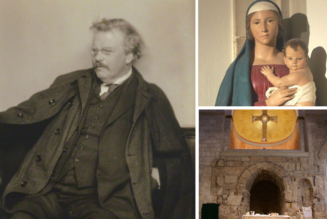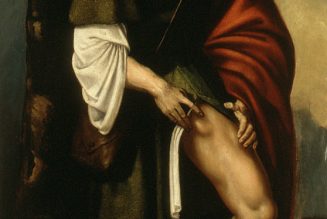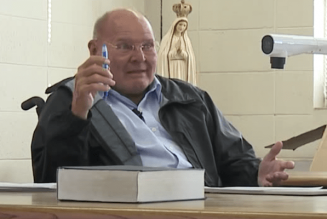
I teach journalism at The King’s College in New York City. I have for the past four years. GetReligion readers may recall that tmatt used to teach there, as well.
Among the many classes I enjoy teaching is one called “Entrepreneurial Journalism and the Future.” It is a class that teaches aspiring journalists the importance of the business side of the profession and how technology has disrupted the traditional distribution methods by which people consume news.
We all know that the number of people who read a daily newspaper — in paper form that is — has dropped dramatically over the last decade as more people use iPads and smartphones to connect to information. The news ecosystem has grown to envelope legacy news organizations such as The New York Times and Washington Post to digital-only sites like Buzzfeed and Vice.
The Catholic news world has also seen its share of startups since the internet has changed the news industry. It’s these changes that have brought more issues like fake news and misinformation, but also allowed journalists to become entrepreneurs and build start-ups of their own.
Journalists have found news and innovative ways — like the growing subscription platform Substack — to tell stories and do great journalism.
One of the bright spots of 2021 so far has been The Pillar. Founded by journalists (and canon lawyers) J.D. Flynn and Ed Condon who have experience at a variety of places like Catholic News Agency, The Pillar says its “a Catholic media project focused on smart, faithful, and serious journalism, from committed and informed Catholics who love the Church.”
This is what else they claim to be:
Our focus is on investigative journalism, which is how we’ll spend most of our time. We think investigating stories that matter can help the Church to better serve its sacred mission, the salvation of souls.
As we work on investigative projects, we’ll also produce analyses, explainers, and podcasts, and we’ll send them to you.
We believe that serious Catholic journalism is a service to Christ and the Church – and that journalism can be done in a uniquely Catholic way, which takes the doctrine of the Catholic Church to be true, which treats people with respect, and which looks for the truth above all else, without getting bogged down in partisan agendas or mudslinging.
We think the story matters more than we do, and we’d rather tell you the facts than tell you what we think. We aim to focus on the facts, and to provide the context and background that helps make sense of them.
The Pillar upholds the highest standards of journalistic independence and craftsmanship. We’re independent of any ecclesial agenda but the holiness of the Church and its members — we won’t be afraid to tell the stories that need to be told, but we’ll tell them with integrity and fairness.
The Pillar has it all: a website, email newsletter and podcast. All of them deliver up-to-date reporting on the church as well as analysis.
One of its strengths is its investigative journalism. They are taking the time to cover stories other publications — secular and religious — are not covering. While high standards and fairness are welcome addition to journalism at this time, especially when reporting on very important issues around religion and faith, this is a site that also can be innovative in its storytelling.
The biggest player in Catholic news in this country is EWTN. Founded by a nun named Mother Angelica in 1980, the Catholic news giant has a multimedia presence. It owns the National Catholic Register newspaper, which it acquired in January 2011, and Catholic News Agency. But The Pillar can do what EWTN can and then some. A small staff makes them nimble, the mark of a true startup, and can have some fun while reporting on weighty topics regarding the Vatican.
Indeed, The Pillar does likes to have some fun both on its website and podcasts. An explainer posted on April 16 did just that in trying to simplify the ongoing Vatican bank scandal and its many players. This is how The Pillar did it:
Vatican City State prosecutors have not yet said when they plan to take any of the figures in their sprawling Vatican financial investigation to an actual criminal trial. But eventually they’ll draft somebody to the Big Courtroom Dance.
So to get ready, The Pillar brings you the Vatican Finance Scandal Draft Rankings™.
Our experts tell you who’s most likely to get drafted into a courtroom, where they’ll end up answering questions — or at least facing them — from Vatican prosecutors bent on scoring a win with the judges.
Plus: Who’s accused of what, who’s already in court where, and who is suing – or threatening to sue – whom.
The post goes on, in great detail, about the players involved and details about each in a way that makes the subject both interesting and easy to understands in a way that marries creative writing to an ESPN-style sports piece.
Creative religion reporting? You bet! It’s this type of journalism entrepreneurship that merits kudos and a welcome addition to my inbox.
But the site has also done wonderful investigative pieces, exhibiting the type of curiosity and fair reporting that has honestly been lacking at many mainstream news organizations who have traditionally made it their mission to do such reporting.
Case in point: A story under the headline “Tithes in corona-time: Who gave more, who stopped giving, and why” which ran on March 24, the third and final installment that was part of a series. (See this tmatt “On Religion” column about the project.)
Here’s the thesis of the piece:
The year 2020 was a tumultuous time for Catholic tithing throughout the United States. When Masses shuttered throughout the country due to the pandemic, Catholic parishes feared the worst — massive losses due to lockdowns, layoffs and dropped donations.
While overall giving is down, things are not as dire as they were first feared. A study of 100 parishes across 10 dioceses, conducted by Brendan Hodge for The Pillar, found that Sunday offertory collections dropped by an average of 12% between 2019 and 2020. While some parishes saw big swings – a majority-Hispanic parish in California reported a 44% drop in donations, while a small parish in South Dakota reported a 35% increase – most landed somewhere in the middle.
Part of the reason donations did not fall more drastically is because many people who were still in a position to give decided to give more.
In part one of the series, posted on March 22, The Pillar discussed how it came up with the series and the data they used. Here’s a piece from that report:
To assess the impact of the pandemic on the financial health, we created a database of 2019 and 2020 parish collections data from 100 parishes in dioceses in ten selected ecclesiastical provinces across the U.S.
To conduct our study, we had to select parishes with an online archive of at least two years of bulletins, and which included parish collection data in their bulletins. But in all other respects we tried to get a completely random sample: the parishes within our study represent a broad range of income levels, population densities, and demographics.
Again, it is this type of creativity that makes readers want to return. It’s this type of entrepreneurship that makes for a great business model and wonderful journalism that stands out.
The Pillar, which launched just four months ago, has been the surprise startup of the year. This is exactly the type of religion journalism, specifically as it relates to Catholicism, that we need at this moment. It’s what the audience craves and it helps everyone understand the sometimes-complicated world of Catholicism.
Join Our Telegram Group : Salvation & Prosperity









